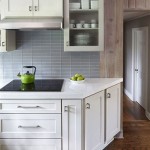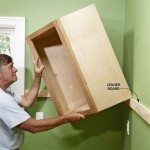Best Solutions to Clean White Kitchen Cabinets
White kitchen cabinets, a hallmark of modern and traditional design, brighten spaces and create an illusion of spaciousness. However, their pristine surface is also highly susceptible to showing dirt, grease, and stains. Maintaining the aesthetic appeal of white kitchen cabinets requires regular cleaning and the application of effective cleaning solutions. This article explores various methods and products suitable for cleaning white kitchen cabinets, catering to different types of stains and material finishes.
The frequency of cleaning depends heavily on usage. Cabinets near the stovetop require more frequent attention due to grease splatters. A weekly wipe-down is generally recommended for high-traffic areas, while less exposed cabinets can be cleaned bi-weekly or monthly. Addressing spills and splatters immediately prevents stains from setting and becoming more difficult to remove.
Understanding Cabinet Materials and Finishes
Before selecting a cleaning solution, it is crucial to identify the material and finish of the cabinets. Common materials include wood (painted or laminated), laminate, and thermofoil. Each material reacts differently to various cleaning agents. Harsh chemicals, abrasive scrubbers, and excessive moisture can damage or discolor certain finishes. For instance, solid wood cabinets, especially those with a painted finish, are more susceptible to scratches and water damage compared to laminate or thermofoil cabinets. Laminate cabinets are generally more durable and resistant to moisture, but they can still be damaged by harsh chemicals.
Cabinets with a matte finish require gentler cleaning methods compared to those with a glossy finish. Matte finishes tend to absorb stains more readily, necessitating careful application of cleaning solutions and thorough rinsing. High-gloss finishes are easier to wipe clean but are more prone to showing streaks and smudges. Therefore, the cleaning process should be tailored to the specific cabinet material and finish to ensure effective cleaning without causing damage.
Effective Cleaning Solutions for White Kitchen Cabinets
Several cleaning solutions are effective for removing dirt and grime from white kitchen cabinets. These solutions range from readily available household products to specialized cabinet cleaners. The best solution depends on the severity of the stains, the cabinet material, and personal preferences.
Dish Soap and Warm Water: A mixture of dish soap and warm water is a gentle yet effective cleaner for everyday dirt and grease. Choose a mild dish soap that does not contain harsh chemicals or abrasives. Simply mix a few drops of dish soap into a bowl of warm water. Dip a soft cloth or sponge into the solution, wring out the excess water, and wipe down the cabinets. Rinse the cabinets with a clean, damp cloth and dry them thoroughly.
Baking Soda Paste: Baking soda is a natural and mild abrasive that can remove stubborn stains and grime. Create a paste by mixing baking soda with a small amount of water until it forms a thick consistency. Apply the paste to the stained areas, let it sit for a few minutes, and then gently scrub with a soft cloth or sponge. Rinse the cabinets thoroughly with water and dry them completely. Baking soda is particularly effective for removing grease stains and watermarks.
Vinegar and Water Solution: Vinegar is a natural disinfectant and degreaser that can effectively clean white kitchen cabinets. Mix equal parts of white vinegar and water in a spray bottle. Spray the solution onto the cabinets and let it sit for a few minutes. Wipe the cabinets with a clean, damp cloth and dry them thoroughly. While vinegar is effective, it has a strong odor that may be unpleasant to some. The smell will dissipate after a short time.
Commercial Cabinet Cleaners: Numerous commercial cabinet cleaners are specifically formulated for cleaning kitchen cabinets. These cleaners often contain specialized ingredients that remove grease, grime, and stains without damaging the cabinet finish. When using a commercial cleaner, it is essential to read and follow the manufacturer's instructions carefully. Test the cleaner on an inconspicuous area of the cabinet before applying it to the entire surface to ensure it does not cause discoloration or damage.
Magic Erasers: Melamine sponges, often sold under the brand name Magic Eraser, are effective for removing scuff marks and stubborn stains. These sponges contain micro-abrasives that gently lift dirt and grime from surfaces. Wet the sponge and wring out the excess water before using it to clean the cabinets. Be cautious when using magic erasers on glossy finishes, as they can potentially dull the surface. It's generally advisable to test the sponge on a hidden area first.
Oil Soap: Oil soap is a gentle cleaner that can clean and condition wood cabinets. It helps to restore the natural oils in the wood and prevent it from drying out. Dilute the oil soap according to the manufacturer's instructions and apply it to the cabinets with a soft cloth. Rinse the cabinets with a clean, damp cloth and dry them thoroughly.
Steps for Cleaning White Kitchen Cabinets
The cleaning process involves several steps to ensure effective stain removal and prevent damage to the cabinets. Adhering to these steps will contribute to preserving the cabinets' appearance and extending their lifespan.
Preparation: Before starting the cleaning process, remove all items from the countertops near the cabinets. Cover the countertops with a drop cloth or towels to protect them from spills and splatters. Open windows or turn on the exhaust fan to provide ventilation.
Dusting: Use a soft brush or a vacuum cleaner with a brush attachment to remove dust and loose debris from the cabinets. Pay attention to corners, crevices, and decorative moldings where dust tends to accumulate. Removing the dust before cleaning prevents it from turning into a muddy mess when mixed with the cleaning solution.
Applying the Cleaning Solution: Apply the chosen cleaning solution to a soft cloth or sponge. Wring out the excess water to prevent the solution from dripping onto the floor or countertops. Gently wipe the cabinets in a circular motion, focusing on areas with stains or grime. Avoid using excessive pressure, as this can damage the cabinet finish.
Rinsing: After cleaning the cabinets, rinse them with a clean, damp cloth. Use a separate cloth for rinsing to avoid transferring dirt and grime back onto the cabinets. Ensure that all traces of the cleaning solution are removed.
Drying: Dry the cabinets thoroughly with a clean, dry cloth. This prevents water spots and streaks from forming. Pay attention to corners and crevices where water tends to accumulate.
Addressing Specific Stains and Issues
Certain types of stains require specific treatment methods to ensure effective removal. Understanding how to address these stains is crucial for maintaining the appearance of white kitchen cabinets.
Grease Stains: Grease stains are common in kitchens, particularly on cabinets near the stovetop. To remove grease stains, use a degreasing cleaner such as dish soap, vinegar, or a commercial degreaser. Apply the cleaner to the stained area, let it sit for a few minutes, and then wipe it away with a clean cloth. For stubborn grease stains, create a paste of baking soda and water and apply it to the stained area. Let the paste sit for a few minutes, and then gently scrub with a soft cloth or sponge. Rinse the cabinets thoroughly and dry them completely.
Water Stains: Water stains can occur from spills or condensation. To remove water stains, try wiping the area with a soft cloth dampened with equal parts of white vinegar and water. For stubborn water stains, create a paste of baking soda and water and apply it to the stained area. Let the paste sit for a few minutes, and then gently scrub with a soft cloth or sponge. Rinse the cabinets thoroughly and dry them completely.
Mold and Mildew: Mold and mildew can grow in damp areas, such as around the sink or dishwasher. To remove mold and mildew, mix equal parts of bleach and water in a spray bottle. Spray the solution onto the affected area, let it sit for a few minutes, and then scrub with a soft brush or sponge. Rinse the cabinets thoroughly and dry them completely. Always wear gloves and eye protection when working with bleach.
Scuff Marks: Scuff marks can occur from everyday wear and tear. To remove scuff marks, use a magic eraser or a soft cloth dampened with a mild abrasive cleaner. Gently rub the scuff marks until they disappear. Be careful not to damage the cabinet finish.
Preventative Measures for Maintaining White Kitchen Cabinets
Taking preventative measures can significantly reduce the frequency and intensity of cleaning required for white kitchen cabinets. These measures help to protect the cabinets from stains and damage, preserving their appearance over time.
Regular Wipe-Downs: Regularly wipe down the cabinets with a damp cloth to remove dust, dirt, and spills before they have a chance to set. Focus on high-traffic areas, such as those near the stovetop and sink.
Using Backsplashes: Install backsplashes behind the stovetop and sink to protect the cabinets from splatters and spills. Backsplashes are available in a variety of materials and styles, allowing you to choose one that complements your kitchen décor.
Prompt Spill Cleanup: Clean up spills immediately to prevent stains from setting. Use a clean cloth to blot the spill, avoiding rubbing, which can spread the stain.
Avoiding Harsh Chemicals: Avoid using harsh chemicals or abrasive cleaners on white kitchen cabinets, as these can damage the finish. Stick to gentle cleaning solutions, such as dish soap and water, vinegar, or baking soda.
Proper Ventilation: Ensure proper ventilation in the kitchen to prevent moisture buildup, which can lead to mold and mildew growth. Use the exhaust fan when cooking or washing dishes.
Protective Coatings: Consider applying a protective coating to the cabinets to help repel stains and make them easier to clean. Several commercial cabinet protectors are available that can provide an additional layer of protection without altering the appearance of the cabinets.

How To Clean White Kitchen Cabinets 3 Best Ways Avoid Abbotts At Home

How To Clean White Kitchen Cabinets 3 Best Ways Avoid Abbotts At Home

3 Super Easy Ways To Clean White Kitchen Cabinets And Avoid

How To Clean White Kitchen Cabinets 3 Best Ways Avoid Abbotts At Home

How To Clean White Kitchen Cabinets 3 Best Ways Avoid Abbotts At Home

The Complete Guide To Keeping White Cabinets Clean Cabinet Now

The Complete Guide To Keeping White Cabinets Clean Cabinet Now

The Best Way To Clean Kitchen Cabinets Angie Holden Country Chic Cottage

The Complete Guide To Keeping White Cabinets Clean Cabinet Now

What S The Best Way To Clean Your White Kitchen Cabinets Ag Williams
Related Posts








